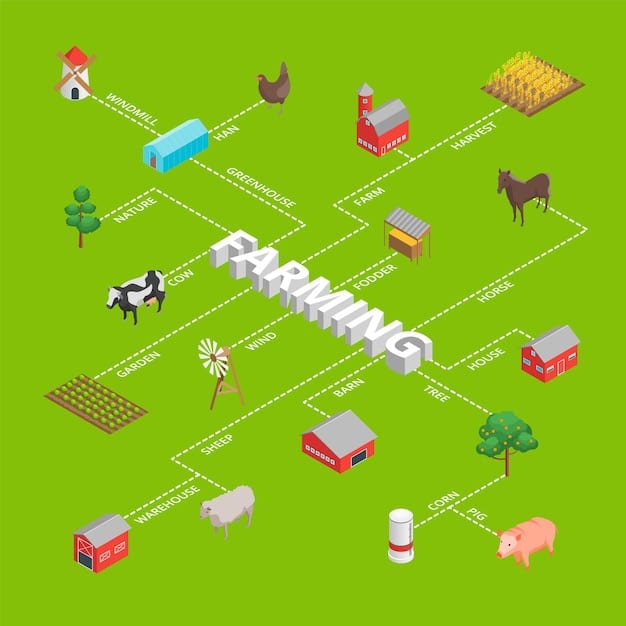Lab-Grown Meat: Will It Disrupt the US Food Industry by 2026?

The potential for lab-grown meat to disrupt the US food industry by 2026 is complex, contingent on regulatory approval, scalable production, cost competitiveness, and consumer acceptance, making a full market overhaul by that date unlikely yet significant advancements are anticipated.
The culinary landscape of the United States has long been defined by traditional agricultural practices, but a new contender is rapidly emerging from scientific laboratories: lab-grown meat. The pressing question on many minds in the food sector, among investors, and even at dinner tables across the nation is: Will lab-grown meat disrupt the US food industry by 2026? This inquiry probes not just technological feasibility but also the intricate dance between regulation, economic viability, and consumer perception, all within a remarkably narrow timeframe.
The Evolution of Cultivated Meat: A Scientific Triumph
The concept of growing meat without raising and slaughtering animals was once confined to the realm of science fiction. Today, it stands as a testament to biotechnological ingenuity. The journey of cultivated meat, from initial cell extraction to a consumable product, involves intricate tissue engineering and bioreactor technology. Scientists meticulously select animal cells, often procured through a non-invasive biopsy, which are then fed a nutrient-rich medium, allowing them to multiply and differentiate into muscle and fat cells, replicating the structure and texture of conventional meat. This process demands precise control over environmental conditions, nutrient supply, and waste removal, akin to brewing beer on a microscopic scale, but with living cells as the fermenting agents.
This scientific endeavor has attracted significant investment, driving rapid advancements in scalability and cost reduction. Early prototypes were prohibitively expensive, costing thousands of dollars per pound. However, continuous innovation in bioreactor design, optimization of growth media—particularly moving away from animal-derived serum—and improved cell line efficiencies have dramatically brought down production costs. Companies are now focusing on larger, more efficient bioreactors, some capable of handling volumes in the tens of thousands of liters, critical for achieving industrial scale. This technological leap is not merely about replicating meat; it’s about creating a sustainable and ethical alternative without the extensive land, water, and greenhouse gas footprint associated with traditional livestock farming.
From Lab to Plate: Key Technological Milestones
The path to commercial viability is studded with technological breakthroughs.
- Cell Line Development: Isolating and immortalizing specific cell lines that can proliferate indefinitely without losing their characteristics.
- Growth Medium Optimization: Developing affordable, animal-free, and scalable nutrient solutions to feed the cells.
- Bioreactor Design: Engineering bioreactors that can efficiently grow large quantities of cells in a sterile and controlled environment.
- Scaffolding and Texturization: Creating structures to mimic muscle tissue, providing texture and mouthfeel similar to conventional meat.
The focus remains on replicating the sensory experience of traditional meat, from the sizzle in the pan to the savory taste. Researchers are exploring various cell types and combinations to mimic beef, chicken, pork, and even seafood, leveraging their understanding of molecular gastronomy. The challenge isn’t just to grow cells; it’s to grow delicious, nourishing, and affordable food at an unprecedented scale. However, the question of whether these advancements can translate into widespread US market availability within a mere two years remains a complex one, deeply intertwined with regulatory hurdles and consumer readiness.
Regulatory Hurdles and the Path to Market Approval
Before lab-grown meat can truly disrupt the US food industry, it must navigate a complex web of regulatory approvals. In the United States, the Food and Drug Administration (FDA) and the Department of Agriculture (USDA) share oversight. The FDA primarily assesses the safety of the cell lines and the growth media, ensuring they meet rigorous food safety standards. Once the cellular product is deemed safe for consumption, the USDA steps in to regulate the production, processing, and labeling of these meat products, ensuring they meet the same inspection standards as conventionally produced meat. This dual agency approach, while designed to be comprehensive, can be lengthy and intricate.
The collaboration between the FDA and USDA signifies a proactive stance by the US government to establish a clear regulatory framework for cultivated meat. This is a significant step forward, as regulatory uncertainty has been a major barrier for many nascent food technologies. Companies developing lab-grown meat must submit extensive data on the safety of their production processes, the purity of their ingredients, and the nutritional profile of their final products. This often involves lengthy toxicological studies, allergen assessments, and detailed manufacturing process descriptions. While significant progress has been made with initial approvals, scaling up production requires continuous oversight and potentially new regulatory considerations as technologies evolve.
It is important to acknowledge that obtaining initial approval for a limited product doesn’t automatically pave the way for mass market adoption. Each new product type or significant alteration in the production process may require additional regulatory scrutiny. This phased approach to approval ensures consumer safety but also slows down the pace of market entry. The speed at which these companies can submit comprehensive dossiers, coupled with the agencies’ capacity to review them, will largely dictate market availability by 2026. The precedent set by initial approvals provides a blueprint, yet the path ahead for broad commercialization is far from fully cleared.

Key Regulatory Milestones Achieved and Challenges Ahead
Several companies have already secured significant regulatory milestones.
- Initial FDA Green Light: Upside Foods and Good Meat, among others, have received “No Questions” letters from the FDA regarding the safety of their cultivated chicken products.
- USDA Inspection Grants: Following FDA’s green light, these companies also secured USDA grants of inspection, allowing them to produce and sell cultivated chicken in the US.
- Labeling Debates: Discussions persist around appropriate labeling to ensure consumers understand what they are buying without misleading them.
Despite these advancements, challenges remain. The regulatory frameworks are still evolving, particularly concerning novel ingredients in growth media or advanced scaffolding materials. International regulatory harmonization is also a factor, as US companies eye global markets, which may have differing standards. The bureaucratic process, while essential for safety, inherently adds time to market entry, making widespread disruption by 2026 a formidable, though not impossible, task. The industry’s ability to swiftly navigate these channels will be crucial.
Economic Viability: Cost, Scale, and Competition
The economic viability of lab-grown meat is arguably the most significant determinant of its potential to disrupt the US food industry by 2026. Currently, cultivated meat is significantly more expensive to produce than conventional meat, largely due to high costs associated with growth media, bioreactor infrastructure, and energy consumption. While prices have dramatically fallen from initial experimental stages, achieving cost parity with, or even undercutting, traditional meat products remains a primary objective. Companies are investing heavily in research and development to optimize nutrient formulations, improve cell yield, and develop more energy-efficient bioreactor systems.
Scaling up production from small lab prototypes to industrial capacities involves massive capital investment. Building large-scale bioreactor facilities, similar to those used in pharmaceutical or fermentation industries, requires substantial funding and a robust supply chain for raw materials. The economies of scale are critical here; as production volumes increase, per-unit costs are expected to decrease significantly. However, this takes time and consistent investment. Many startups in the cultivated meat sector are still in early stages of scaling, with pilot plants rather than full commercial operations. The speed at which they can secure funding, construct facilities, and optimize production lines will define their market penetration.
Moreover, cultivated meat will not enter an empty market; it faces fierce competition from established conventional meat producers, as well as plant-based alternatives. Conventional meat benefits from centuries of optimized farming practices, extensive infrastructure, and deeply ingrained consumer habits. Plant-based alternatives, while distinct, have already carved out a niche in the market, often at lower price points and with greater accessibility. For lab-grown meat to truly disrupt the industry, it must offer a compelling value proposition that goes beyond novelty – whether that’s superior sustainability, ethical sourcing, unique nutritional benefits, or eventually, competitive pricing that appeals to a broad consumer base.
Factors Influencing Cost Reduction and Market Entry
The industry is employing several strategies to drive down costs.
- Cheaper Growth Media: Transitioning from expensive pharmaceutical-grade components to food-grade, scalable alternatives.
- Larger Bioreactors: Designing and implementing bioreactors that can handle thousands of liters, maximizing output.
- Process Efficiency: Optimizing cell density, nutrient utilization, and harvesting techniques to reduce turnaround times.
- Government Subsidies and Incentives: Potential for government support to accelerate infrastructure development and R&D.
While significant progress is anticipated in cost reduction and scaling by 2026, achieving the volumes and price points necessary for true disruption against deeply entrenched incumbents is a monumental hurdle. It’s more likely that cultivated meat will establish a premium niche market initially, gradually expanding as technologies mature and costs decline further, rather than completely overturning the status quo within such a short timeframe.
Consumer Acceptance: Palate, Perception, and Price
Consumer acceptance is the ultimate gatekeeper for lab-grown meat’s widespread adoption and its potential for disruption. No matter how scientifically advanced or economically viable, if consumers are unwilling to embrace it, market penetration will be limited. Public perception of cultivated meat is influenced by a myriad of factors, including its novelty, concerns about “unnatural” food, ethical considerations, and curiosity. Early research indicates a segment of consumers intrigued by the sustainability and ethical aspects, but also a significant portion expressing skepticism or outright rejection due to discomfort with the concept of “meat grown in a lab.”
Sensory attributes—taste, texture, and appearance—are paramount. Consumers expect cultivated meat to be indistinguishable from, or even superior to, conventional meat. Initial product launches, even in limited quantities, will be crucial in shaping public opinion. A negative first impression due to sub-par sensory quality could set back adoption considerably. Companies are heavily investing in sensory panels and consumer testing to refine their products, ensuring they meet the high expectations of the American palate. Marketing and branding will play a critical role in educating consumers about the benefits and dispelling misconceptions, framing it not as a replacement but as an alternative choice.
The price point will also heavily influence consumer adoption. While initial products may target premium markets willing to pay more for novelty or ethical considerations, mass market disruption requires price competitiveness. Consumers are often unwilling to pay a significant premium for a product unless it offers clear and tangible benefits that resonate personally. Education campaigns highlighting environmental benefits, animal welfare, and potential health advantages (e.g., reduced risk of foodborne pathogens, controlled nutritional profile) will be key to building consumer trust and demand. However, shifting deeply ingrained dietary habits and overcoming initial skepticism will be a gradual process, making a complete overhaul by 2026 a highly optimistic scenario.
Addressing Consumer Concerns and Building Trust
Strategies to foster consumer acceptance include:
- Transparent Labeling: Clearly indicating that the product is cultivated meat, along with its origin and benefits.
- Public Education Campaigns: Explaining the science behind cultivated meat, its safety, and its environmental advantages.
- Celebrity Endorsements/Chef Partnerships: Introducing cultivated meat through trusted culinary figures.
- Taste and Texture Optimization: Ensuring the product delivers an excellent eating experience comparable to conventional meat.
The timeline for shifting consumer perceptions is typically longer than for technological advancements. While innovative marketing could accelerate this, transforming deeply held beliefs about food naturally takes time. Therefore, while a niche market might establish itself by 2026, widespread adoption sufficient to cause full industry disruption seems less probable given the complex interplay of consumer preferences and perceptions.
Environmental Impact and Sustainability Claims
One of the most compelling arguments for lab-grown meat is its potential to significantly reduce the environmental footprint associated with traditional livestock farming. Livestock agriculture is a major contributor to greenhouse gas emissions, deforestation, land degradation, and water pollution. Supporters of cultivated meat argue that it offers a more sustainable pathway to feed a growing global population. Studies, though varied in their methodologies and assumptions, generally suggest that cultivated meat could require substantially less land, water, and emit fewer greenhouse gases per pound of meat produced compared to conventional methods.
The sustainability claims depend heavily on the energy source used in production. If bioreactors are powered by renewable energy, the environmental benefits are amplified. Conversely, if fossil fuels are the primary energy source, the environmental advantages might be less pronounced, or even negated, depending on the specific life cycle assessment. This underscores the importance of developing integrated sustainable production systems that consider the entire supply chain, from nutrient media production to waste management. Companies are actively exploring ways to make their processes as eco-efficient as possible, recognizing that environmental stewardship is a key part of their value proposition.
Beyond direct environmental benefits, cultivated meat could also alleviate pressure on natural ecosystems by reducing the need for extensive grazing lands and feed crop cultivation. This could free up land for reforestation, biodiversity conservation, and other ecological restoration efforts. The reduction in animal waste could also mitigate water contamination issues. However, the environmental impact argument also faces scrutiny, with some questioning the energy intensity of large-scale bioreactor operations and the overall resource requirements. By 2026, the industry aims to have more definitive data and demonstrate tangible environmental improvements in their pilot and early commercial facilities, strengthening their position in the sustainable food landscape.
Comparative Sustainability Analysis: Lab-Grown vs. Traditional
Key environmental advantages touted by cultivated meat proponents:
- Reduced Land Use: Significantly less arable land required compared to raising livestock.
- Lower Water Consumption: Substantially less water needed for production compared to conventional farming.
- Decreased Greenhouse Gas Emissions: Potential for dramatically lower carbon footprint, especially with renewable energy use.
- Mitigated Pollution: Reduced nutrient runoff and antibiotic use, benefiting ecosystems and public health.
While the long-term environmental benefits appear promising, achieving these at commercial scale within a few years is a significant challenge. The infrastructure for sustainable cultivated meat production is still being built, and optimizing it for minimal environmental impact will be an ongoing process. Therefore, while cultivated meat will contribute to sustainability efforts by 2026, its full environmental transformative potential may require more time to materialize.
The Role of Investment and Industry Partnerships
The rapid advancement of the lab-grown meat industry has been fueled by a significant influx of venture capital and strategic investments. Both specialized food tech funds and traditional venture capitalists have poured hundreds of millions of dollars into cultivated meat startups. This funding is crucial for research and development, building pilot facilities, hiring scientific talent, and navigating complex regulatory landscapes. The willingness of investors to back these high-risk, high-reward ventures signals confidence in the long-term potential of cultivated meat to become a substantial segment of the food market.
Beyond financial investment, strategic partnerships with established players in the food industry are becoming increasingly vital. Large meat companies, food processing giants, and even pharmaceutical companies are investing in or collaborating with cultivated meat startups. These partnerships provide not only capital but also invaluable expertise in scaling production, supply chain management, distribution, and marketing. Leveraging existing infrastructure and market access can significantly accelerate the path to commercialization for nascent cultivated meat companies. For instance, major meat processors exploring cultivated meat signal an understanding that diversification into alternative proteins is essential for future growth and market relevance.
These collaborations often involve joint ventures, minority investments, or technology licensing agreements. They reflect a growing realization within the traditional food industry that ignoring the cultivated meat trend is no longer a viable strategy. Instead, embracing it through partnership allows incumbents to hedge their bets, gain insights into new technologies, and potentially integrate innovative products into their portfolios. By 2026, these strategic alliances are expected to become more prevalent, streamlining the commercialization process and potentially accelerating market entry of cultivated meat products. However, the exact impact on the broader US food industry will depend on the scale and success of these collaborations.
Impact of Funding and Partnerships on Market Acceleration
Investment and collaborations are accelerating the industry’s growth in several ways:
- Rapid R&D: Funding enables faster iteration and optimization of cell lines, growth media, and bioreactor technology.
- Infrastructure Development: Capital is essential for building and scaling production facilities.
- Market Access: Partnerships with established food companies provide crucial distribution channels and consumer reach.
- Talent Acquisition: Investment allows companies to attract top scientific, engineering, and business talent.
The infusion of capital and strategic alliances suggests a dynamic shift in the food landscape. While they won’t guarantee full disruption by 2026, they significantly enhance the cultivated meat industry’s capacity to overcome challenges and gain a foothold in the US market. The strategic foresight of traditional players embracing this technology is a powerful indicator of its long-term potential.
Future Outlook: A Gradual Transformation, Not Instant Disruption by 2026
Looking ahead to 2026, the question of whether lab-grown meat will cause a fundamental disruption in the US food industry necessitates a nuanced answer. While revolutionary advancements have been made in cultivated meat technology, and initial regulatory approvals are a positive sign, a complete overhaul of the US food system within such a short timeframe appears unlikely. The inherent complexities of scaling production, achieving cost competitiveness with conventional meat, and securing widespread consumer acceptance are profound challenges that typically require more than two years to overcome on a national scale.
Rather than an instant disruption, a more probable scenario by 2026 is a gradual transformation. Lab-grown meat will likely establish itself as a niche, premium product, initially available in select high-end restaurants or specialty retail outlets. Early adopters, driven by ethical, environmental, or health considerations, will form the primary consumer base. This limited market entry will provide invaluable data on consumer preferences, production challenges at near-commercial scale, and cost efficiencies. The industry will use this period to continue refining its products, optimizing processes, and working towards greater price parity and broader distribution.
The true disruptive potential of lab-grown meat lies further in the future, likely beyond 2026. As technology matures, production costs decrease, and consumer familiarity grows, cultivated meat could become a more mainstream option. It may initially complement, rather than completely replace, conventional meat products. The US food industry is a colossal and deeply entrenched ecosystem, and shifts of this magnitude are inherently slow. By 2026, we can anticipate significant progress, more products on the market, and continued buzz, but the full “disruption” is more likely to unfold over the next decade.
Anticipated Market Trajectory Post-2026
The cultivated meat market is set for expansion, but at a measured pace.
- Premium Market Penetration: Initial focus on high-value segments willing to pay for novelty and ethical benefits.
- Increased Product Variety: Expansion beyond chicken to other meat types like beef, pork, and seafood.
- Continued Cost Reduction: Ongoing efforts to lower production costs through technological innovation and scale.
- Broader Distribution Channels: Gradual move from specialty outlets to mainstream grocery stores as prices become competitive.
Ultimately, by 2026, cultivated meat will have made its mark on the US food industry, not as a sudden tsunami, but as a significant and growing wave. It will be a testament to scientific innovation and a harbinger of a more diversified and sustainable food future, laying the groundwork for more profound changes in the years to follow. The journey towards widespread adoption is a marathon, not a sprint.
| Key Aspect | Brief Description |
|---|---|
| 🔬 Tech Advances | Significant progress in cell growth & bioreactor design, but large-scale production still evolving. |
| ⚖️ Regulatory Path | Initial US approvals gained, but broader market entry requires more oversight and time. |
| 💰 Economic Viability | Costs much higher than conventional meat; achieving parity by 2026 is challenging. |
| 🛒 Consumer Acceptance | Variable public perception, requiring education and excellent product quality for widespread adoption. |
Frequently Asked Questions about Lab-Grown Meat
▼
Yes, regulatory bodies like the FDA and USDA conduct rigorous safety assessments. Companies must demonstrate their products are safe for human consumption before market entry, following strict protocols for cell lines and production. Initial products have met these safety standards.
▼
Lab-grown meat is real animal meat, grown from animal cells, identical on a cellular level to conventional meat. Plant-based alternatives, conversely, are made from plant proteins (like soy or pea) and other ingredients to mimic meat’s taste and texture.
▼
Cultivated meat generally requires significantly less land and water than traditional livestock farming. It also has the potential to produce far fewer greenhouse gas emissions, especially as production scales and relies on renewable energy sources, contributing to sustainability goals.
▼
While costs have dramatically decreased, achieving broad affordability or price parity with conventional meat by 2026 remains a significant challenge. It is more likely to enter the market as a premium product, with future cost reductions enabling wider access.
▼
The goal of cultivated meat is to replicate the taste, texture, and sensory experience of conventional meat. Companies are heavily investing in research to ensure their products are indistinguishable from or even superior to traditionally farmed counterparts in flavor and mouthfeel.
Conclusion
In conclusion, the question of whether lab-grown meat will fundamentally disrupt the US food industry by 2026 invites a perspective of evolutionary change rather than revolutionary upheaval. While the scientific and technological advancements have been breathtaking, and regulatory pathways are opening, the immense hurdles of scaling production, achieving cost competitiveness, and securing widespread consumer acceptance mean that a full disruption within such a narrow timeframe is improbable. Instead, 2026 will likely mark a pivotal moment where cultivated meat secures a solid foothold, establishing itself as a specialized, premium product within niche markets. This initial presence will serve as a crucial testbed, allowing the industry to refine processes, lower costs, and incrementally build consumer trust. The true transformative impact of lab-grown meat on the US food landscape is more likely to unfold gradually over the subsequent decade, as it moves from novelty to a viable and increasingly accessible alternative, thereby shaping the future of food in a more measured but ultimately profound way.






